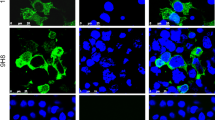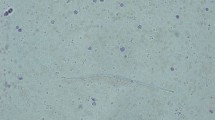Abstract
A method of isolatingBabesia ovata merozoites from infected erythrocytes and an enzyme-linked immunosorbent assay (ELISA) for the detection of anti-B. ovata antibodies were developed. AfterB. ovata-infected erythrocytes had been lysed using the nitrogen cavitation method, the merozoites were separated from erythrocyte components by differential centrifugation and density-gradient centrifugation. The light microscopic examination showed that the purified merozoites were morphologically intact and contained few contaminants. Sodium dodecyl sulfate-polyacrylamide electrophoretic (SDS-PAGE) analysis revealed that the merozoite fraction contained very little contamination with erythrocyte components. The merozoites thus obtained were sonicated and treated with Triton X-100 and then used as an antigen to measure anti-B. ovata antibodies in ELISA. The ELISA was more sensitive in detecting anti-B. ovata antibodies than was either the indirect fluorescent antibody test or the complement fixation test on sera from cattle infected withB. ovata.
Similar content being viewed by others
References
Allsopp BA, Wagner GG, Mathews KP, Kariavu CG (1977) Purification and characterization of precipitating antigens fromTheileria parva. J Gen Microbiol 100:319–328
Barry DN, Rodwell BJ, Timms P, McGregor W (1982) A microplate enzyme immunoassay for detecting and measuring antibodies toBabesia bovis in cattle serum. Aust Vet J 59:136–140
Dowben HS, Gaffey TA, Lynch PA (1968) Isolation of liver and muscle polyribosomes in high yield after cell disruption by nitrogen cavitation. FEBS Lett 2:1–3
Figueroa JV, Buning GM, Kinden DA (1990) Purification of the erythrocytic stage ofBabesia bigemina from cultures. Paraitol Res 76:675–680
Fujinaga T (1981a) Bovine babesiosis in Japan: clinical and clinicopathological studies on cattle experimentally infected withBabesia ovata. Jpn J Vet Sci 43:803–813
Fujinaga T (1981b) Effect of splenectomy and dexamethasone administration on cattle experimentally infected withBabesia ovata. Jpn J Vet Sci 44:71–88
Fujinaga T, Minami T (1981) Indirect fluorescent antibody and complement fixation tests in the diagnosis of bovine theileriosis and babesiosis in Japan. Vet Parasitol 8:115–126
Fujinaga T, Minami T, Ishihara T (1980) Serological relationship between a largeBabesia found in Japanese cattle andBabesia major, B. bigemina andB. bovis. Res Vet Sci 29:230
Gray MA, Luckins AG, Rae PF, Brown CGD (1980) Evaluation of enzyme immunoassay for serodiagnosis of infections withTheileria parva andT. annulata. Res Vet Sci 29:360–366
Hamburger J, Kreier JP (1980) Isolation of malaria parasites. In: Kreier EJP (ed) Malaria, Vol 3. Academic Press, New York, pp 1–65
Laemmli VK (1970) Cleavage of structural proteins during the assembly of the head of bacteriophage T4. Nature 227:680–685
Mahoney DF, Goodger BV (1981) The isolation ofBabesia parasites and their products from the blood. In: Ristic M, Kreier JP (eds) Babesiosis. Academic Press, New York, pp 323–335
Minami T, Yamabe K, Hayashi S, Ishihara T (1979) Serological relationship of JapaneseBabesia species andBabesia bigemina by the complement fixation and capillary-tube agglutination tests. Vet Parasitol 5:29–38
Nakamura Y, Shimizu S, Minami T, Ito S (1988a) Enzyme-linked immunosorbent assay using solubilised antigen for detection of antibodies toAnaplasma marginale. Trop Anim Health Prod 20:259–266
Nakamura Y, Shimizu S, Minami T, Ito S (1988b) Enzyme-linked immunosorbent assay for detection of antibodies toAnaplasma centrale. Jpn J Vet Sci 50:933–935
O'Donoghue PJ, Friedhoff KT, Vizcanio OG, Weyreter H (1985) The detection of IgM and IgG antibodies againstBabesia bigemina in bovine sera using semi-defined antigens in enzyme immunoassays. Vet Parasitol 18:1–12
Prior RB, Kreier JP (1972)Plasmodium berghei freed from host erythrocytes by a continuous-flow ultrasonic system. Exp Parasitol 32:239–243
Rodriguez SD, Buening GM, Vega CA, Carson CA (1986)Babesia bovis: purification and concentration of merozoites and infected bovine erythrocytes. Exp Parasitol 61:236–243
Sato M, Hirose T, Miyagami T, Sakurai H, Saito A, Suzuki N (1986) A rise and fall of humoral antibody in calves experimentally infected withBabesia ovata orTheileria sergenti. Jpn J Vet Sci 48:599–602
Shimizu S, Suzuki K, Nakamura K, Kadota K, Fujisaki K, Ito S, Minami T (1988) Isolation ofTheileria sergenti piroplasms from infected erythrocytes and development of an enzymelinked immunosorbent assay for serodiagnosis ofT. sergenti infections. Res Vet Sci 45:206–212
Taylor SM, Elliott CT, Kenny J (1986) Isolation of antigenic proteins from erythrocytes parasitized withBabesia divergens and comparison to their immunizing potential. Vet Parasitol 21:99–105
Wagner GG, Duffus WPH, Kimber CD, Lule M (1974) Immunological studies on East Coast fever: I. partial segregation and characterization of theTheileria parva piroplasm antigen. J Parasitol 60:854–859
Wallach DF, Conley M (1977) Altered membrane proteins of monkey erythrocytes infected with simian malaria. J Mol Med 2:119–136
Waltisbuhl DJ, Goodger BV, Wright IG, Commins MA, Mahoney DF (1987) An enzyme-linked immunosorbent assay to diagnoseBabesia bovis infection in cattle. Parasitol Res 73:126–131
Author information
Authors and Affiliations
Additional information
This work was supported in part by a Grant-in-Aid (Bio Media Program) from the Ministry of Agriculture, Forestry and Fisheries (BMP 92-IV-1-7)
Rights and permissions
About this article
Cite this article
Shimizu, S., Shimura, K., Ito, S. et al. Babesia ovata: isolation from erythrocytes and development of an enzyme-linked immunosorbent assay for detection of antibodies. Parasitol Res 78, 684–688 (1992). https://doi.org/10.1007/BF00931521
Accepted:
Issue Date:
DOI: https://doi.org/10.1007/BF00931521




